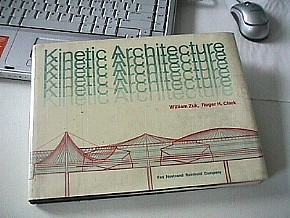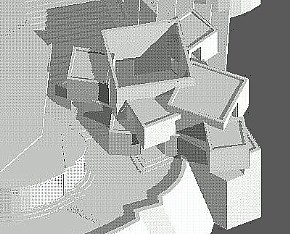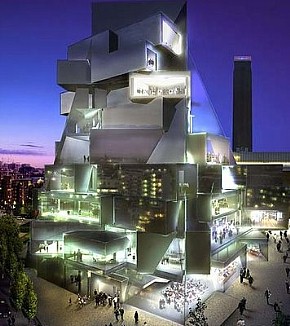2006.02.20 12:48
Iconography, or the problem of representation
...makes me think about the reality(?) that designing can be arbitrary as in willful and/or arbitrary as in decisive. Architects seem well capable of designing both ways.
Are sponges actually a very good symbol for Prada? After all, they do soak up a lot of consumer money.
2006.03.01 11:45
Iconography, or the problem of representation
Architecture has not reached rock bottom, nor is it likely to do so too anytime soon. What is unfortunate, however, is how architects have for the most part been trained to deny a whole bunch of reality.
"This comparison is not about precedents, rather predictabilities."
2006.03.02 11:46
Iconography, or the problem of representation
What I find most suspect is the implied notion that the FOA terminal is now only fully discussible with reference to the Hosukai wave. The real connection between the two artifacts/designs is superficial at best, and in some ways comes off as trying to "pull the wool over everyone else's eyes."
Is it really true that most architects have a hard time communicating their designs to the public? That's not a rhetorical question. I'm seriously wondering what the answer is. I can see where FOA has a hard time communicating their designs to the public, but do most other architects also have a hard time communicating their designs to the public? Have architects overall become more and more unable to communicate their designs? If this is true, then something tells me that it isn't the public that is really most to blame.
2006.03.21 10:23
FUNCTION - physical or metaphysical
What are some examples of buildings that are "designed too specifically for its function"?
What happens when the function still exists, but the community moves away?
Do you know how many original synagogues in Philadelphia are not synagogues anymore? Do you know how many original Roman Catholic Churches in Philadelphia are not Roman Catholic Churches anymore?
2006.03.21 10:57
FUNCTION - physical or metaphysical
My point was that now-a-days communities are just as ephemeral as functions.
I knew factories would come up in terms of functionally specific architecture, mostly because the functional aesthetic in architecture was pretty much inspired by factories.
What a "community" keeps is in large measure contingent on how a building is zoned (or rezoned 'residential'). Here in Philadelphia religious buildings tend to stay religious buildings, and religious buildings "function" mostly because they are tax exempt.
Don't get me wrong though, I'm all for re-use before demolition. I mean, how else could I look at a Cambodian Buddhist Temple after I walk out of the Rite-Aid?
| |
2006.03.29 18:25
Depth
...Venturi may too have seen "that a characteristic of modern architecture, is a move away from depth" and thus worked to exploit that very aspect in his designs. Venturi may too have been inspired by the contemporary architecture being built in Rome while he was at the American Academy in the early 1950s.
One could also say that Kahn earlier introduced "depth" via volumetric geometrics and the "cut-outs" thereof, which, for a while, influenced Venturi and later Matta-Clark.
2006.04.01 10:19
Why does much 'avant-garde' design these days look straight out of the Sixties?
And familiarity and associations are based on memories, either empirical or received via education, and memories are nothing if not reenactments. Add to that that architects are for the most part conservative, and radical only rarely.
2006.04.01 11:30
Why does much 'avant-garde' design these days look straight out of the Sixties?
I like the question, "What would radical be exactly?" because it's kind of indicative of how rare radicalism in architecture really is...
radical
2.Departing markedly from the usual or customary; extreme
3. Favoring or effecting fundamental or revolutionary changes in current practices, conditions, or institutions
2006.04.01 14:24
Why does much 'avant-garde' design these days look straight out of the Sixties?
...I was reminded of being in a local 1960s Roman Catholic church for the first time a few years ago. I was actually quite surprised by it's "radical-ness". I mean, it was the first time I've ever seen a completely black altar in my life. There was indeed something radical about a lot of 60s and 70s architecture.
2006.04.01 17:12
Why does much 'avant-garde' design these days look straight out of the Sixties?
A couple of years ago I specifically looked through the Progressive Architecture design awards from the late 1960s. I wanted to see what Gordon Matta-Clark probably saw himself when he was (still) in architecture school at Cornell. I was very much surprised because a lot of the top prizes were buildings that are now "in history", but not all of them. I'm not sure how this relates to the topic here, but what I saw wasn't exactly what I expected. I guess I'm trying to say that history gets more interesting when it's contextually specific. Is radical retro an option? Extreme Makeover Retro?
2006.04.02 10:26
Why does much 'avant-garde' design these days look straight out of the Sixties?
I more like the notion of being bad in architecture. Talk about voids and opportunities.
| |
2006.04.02 10:27
Why does much 'avant-garde' design these days look straight out of the Sixties?
...and knowing exactly what to do.
2006.04.02 11:45
Why does much 'avant-garde' design these days look straight out of the Sixties?
I wonder if there is or ever was an architecture equivalent to heliocentric theory?
I wonder if there is or ever was an architecture equivalent to atomic theory?
2006.04.02 13:01
Why does much 'avant-garde' design these days look straight out of the Sixties?
Being avant-garde is great because it isn't mediocrity.
Personally, however, I settle for simply radical.
2006.04.24 11:13
Steven Holl's building facades and urban patterns
Holl's (personal) use of watercolors coincides with the rise of CAD within architecture--a not so atypical reaction among those architects that perceived CAD as anti-craft and thus a bad thing.
Mind you, I enjoy watercoloring myself, yet I would never use it to demonstrate how some other medium is somehow evil or inferior. You would think architects are smart enough to embrace or at least consider all the options that are available. (I know, I know, it isn't easy to embrace a medium that one is completely ignorant of.)
2006.04.24 13:03
magazine writer trying to identify the "leading" female architect today
"In the future, everything will be an advertisement [especially journalism?]."
2006.05.05 10:25
Architectural Pedagogy
Since it's one of the things I want to do before I die, I'm developing a course for blind people who want to teach some courses in architecture. It turns out here though that the blind people themselves are already the only people that can effectively teach this course. "It looks like," the blind consultant said, "maybe you should be developing a course for sighted people to learn how to accept blind people as capable of teaching some courses in architecture." "I think you're right, but you still like my idea of buildings (and classrooms) covered in Braille, don't you?" "Oh yeah, especially the one mixed with carved hieroglyphics."
2006.05.14 13:08
OMA USA splitting from OMA Europe??

The Architecture of Split Ends
| |
2006.05.21 17:42
reading KINETIC ARCHITECTURE lately?

Anyone else reading
William Zuk and Roger H. Clark, Kinetic Architecture (New York: Van Nostrand Reinhold Company, 1970)
lately?
From the front flat of the dust jacket:
"Surely our present task is to unfreeze architecture--to make it a fluid, vibrating, changable backdrop for the varied and constantly changing modes of life. An expanding, contracting, pulsating, changing architecture would reflect life as it is today and therefore be part of it"*
Kinetic Architecture captures the very essence of the above statement. But more than that, it gives every architect, engineer, city planner and builder a working knowledge of emerging, evolutionary concepts and ideas which are flexible to the speed, scale, and nature of change today.
Fully evaluating the bold and exciting potentials of architecture which can accommodate time-change effects, the authors provide a wealth of supporting examples which show how man can now, for the first time, construct a physical environment that is adaptable to his specific needs.
Denouncing the "monument syndrome of static, permanent architecture" in light of current needs, the authors persue new architectural mediums which would remain responsive to a broad spectrum of changing conditions. Such buildings might expand, contract, or even move as pointed up in the book's numerous examples and illustrations.
Here you'll gain new insights into the principles and possibilities of dynamic self-erecting structures such as the United States Pavilion on Osaka, Japan . . . incremental structures which have the potential to meet changing pressures through additive, substractive, or substitutive capabilities (which suggest new ideas for the mobile home industry) . . . disposable buildings--a possible solution to cost-benefit problems . . . the merits of a "second-hand" building market based on the capabilities od reversible architecture . . . and many more equally fascinating innovations.
*"Editorial" by Jan Rowan, Progressive Architecture
| |
2006.07.22 10:33
Durand and Sullivan
Although as a rule very sober in his writing, [Durand] loses his temper when he thinks of the never-ending worship of classical features:
Ces orders ne forment point l'essence de l'architecture; le plaisir que l'on attend de leur emploi et de la décoration qui en résulte est nul; cette décoration, elle-même, une chimère; et la dépense dans laquelle elle entraîne, une folie.
The application of the classical orders seems to him just a bad habit, understandable, but regrettable.
--Emil Kaufmann, Architecture in the Age of Reason: Baroque and Post-Baroque in England, Italy, and France, p. 210.
These rigid "orders" seemed to say, "The book is closed; Art shall die."
--Louis H. Sullivan, The Autobiography of an Idea, p. 187.
2006.07.26 17:05
scratch the superficiality
Albeit superficial, there is nonetheless a strong similarity between the design of a portion of Acropolis Q and the new design for the Tate Modern 2 by Herzog and de Meuron.
 
|